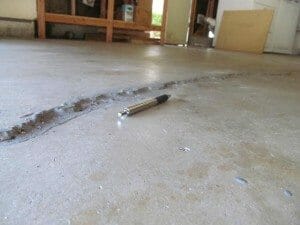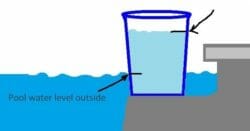Is Cloudy Or Milky Water From a Faucet Safe To Drink

Cloudy or milky looking water from a faucet is usually caused by harmless tiny air bubbles and is safe to drink; however, it can occasionally be a serious warning sign.
There are several tests that you can do yourself to help get a better idea of why your water is cloudy or milky looking.
When a glass is first filled with water from a faucet the water may appear cloudy. To help determine what may be the cause, there are several small tests that you can do and a there are several causes that you may want to consider.
In the big picture, most of the causes involves changes in water temperature, changes in water pressure, which results in tiny microscopic air bubbles getting bigger and becoming more visible, then dissipating.
First Test
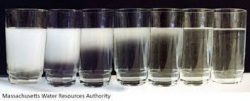
When you fill a glass with water does it clear up, starting at the bottom first and slowly working its way up until the glass is totally clear; does it take one to five minutes? This is a pretty good indication that the milky coloration is microscopic air bubbles working their way to the top and dissipating. If this is the case, then the water is usually considered safe to drink. If the water is still cloudy 12 or 24 hours later, then you may want to contact your local water company.
The temperature change effect
In the U.S. it is not uncommon for the issue of cloudy water to happen more in the winter than the summer if the cause is air bubbles. The reason for this relates to the fact that cold water holds air in a solution better than hot water.
Water coming from your municipal water company or wells is usually cold and travels to your faucets or water heater as cold water. Once the water flows into a glass its temperature rises, and the microscopic air bubbles become larger and will at times cause the water to be cloudy until it dissipates. If you add the effect of pressure, the likelihood of cloudiness increases.
Water pressure effects
Water under pressure holds more air than water not under pressure.
In order to get water from the water company it takes pressure to move it through the pipes to your home. The same is true with a well, both use pumps, which creates the pressure to move water through the water lines or pumps. This water will hold a sizable amount of air.
Once the water under pressure comes out a faucet, it is no longer under pressure, so the microscopic air bubbles are released in the glass of water, sometimes creating a cloudy or milky look. As the air bubbles dissipate from the water it becomes clear.
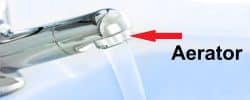
Aerators
An Aerator at the end of a faucet serves several purposes.
- The main purpose is usually to help reduce splashing from the water flow into the sink.
- A lesser known purpose is to help reduce or prevent water from clouding up from air bubbles, for when you break a stream of water into a group of smaller streams or droplets, there is more surface area for the water to dissipate the air bubbles.
- Decreases water usage in many cases because the actual flow is reduced.
- Provides a more uniform shape of water flow out of a faucet.
- Gives a softer or pleasant feel to the stream of water from the faucet.
- Reduces faucet noise.
- Acts as a small filter for small grains of sand, rust or other small particles.
- In homes with low pressure, they may help increase water pressure throughout the house slightly.
Test
If there is an aerator on the faucet, it may be partly clogged with calcium deposits. Try removing it and cleaning the filter. (i.e. place the aerator in a vinegar solution for 2 hours and then brush it with a toothbrush) Replace the aerator to see if this solves the problem.
If no aerator, purchase one from a hardware store or a home improvement store, and place it on the faucet to see if this clears up the cloudiness.
City or municipal water companies
If the local municipal water company is doing work on their water lines or pumping stations the water pressure may build up and this water under more pressure may have a higher level of microscopic air bubbles in it which may account for cloudy or milky water. In the winter months in many localities the water comes from colder than normal sources, especially in Northern states and as we know, colder water holds more microscopic air bubbles than warmer water.
Calling your local water company may have some answers for you if you suspicion that work by them is going on or if they have switched to a colder source of water.
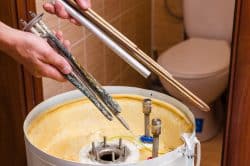
Water heater
Test
Test water at both cold and hot water faucets. If cloudiness appears only at hot water faucets but not the cold-water faucets, then there’s a pretty fair chance that the problem relates to a water heater issue.
In a few instances cloudy water may indicate that there is a water heater issue which may include problems related to anode rods, dissolved solids or water pressure.
Anode rods in water heaters are to reduce corrosion and rust in a water heater; thus, the anode rods help extend the life of the water heater, but they do deteriorate over time which may contribute to dissolved solids showing up in your hot water. In some homes there may be a tendency for the cloudiness to be more prevalent at the first use of hot water in the morning if this is an issue.
“TSS” Total Suspended Solids
Test
Fill a glass with water from a faucet and if its cloudy, check to see if it stays cloudy or if it appears to become clearer at the top area first and slowly becomes clearer going downward, then the issue may relate to “TSS” or tiny particles settling downward to the bottom of the glass.
These particles may include:
- Sediment
- Clay or Silt
- Iron or Manganese
- Algae
Note that the presence of “TSS” / tiny solids may also lead to bacteria growth.
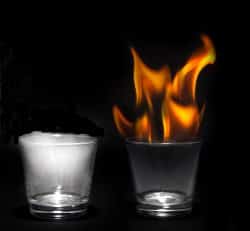
Methane Gas
Water supplied from wells, both private wells or wells that provide water to cities and water districts may have water that contains Methane Gas, which is colorless, odorless and tasteless, and occasionally may show up in drinking water, causing it to be a little cloudy or milky. The U.S. Interior Department has guidelines of what levels are considered to be safe to drink.
- Below 10 mg/L is considered safe
- Between 10 mg/L and 28 mg/L recommends regularly monitored
- Over 28 mg/L requires immediate action (to lower methane levels)
If you suspicion methane gas issues it would be wise to contact the local water department and to have your water tested. Note that under a few rare conditions there may be the possibility of flammability.
Fracking
In rare cases water may be contaminated from methane gas caused by fracking. If you suspicion that there is methane gas, remember that even if there is not an active fracking process going on in your area, it could be from a closed well or an abandoned fracking operation.
Should you have your water tested and if so, how often?
If you are on a public municipal water system, there are testing guidelines that they are required to follow which provides a high degree of safety, however, it is not full proof. In older homes there may be an issue with your pipes, or if you have done plumbing repairs or upgrading, issues may arise or exist.
Private well water source
Should your water come from a private well source, the EPA recommends that you have your water tested a minimum of once a year and more often if:
- You’re pregnant or nursing an infant
- Have an infant under 6 months old in the household
- If you have a new well, or have replaced or repaired pipes, pumps or the well casing
- If the water taste different, smells or started staining items
- If there has been a chemical or fuel spill or leak near your water supply

The majority of time cloudy or milky water from a faucet is caused by tiny microscopic air bubbles in the water and is usually safe to drink. In a few instances, there may be other causes related to the water heater, the water supply from a well or your local water company and in a few rare instances to methane gas issues.
Having your water tested by a qualified lab is a good way to help determine the safeness of your drinking water and if you have any warning signs, doubts or you’re on a private well water supply, it’s highly recommended that you have your water tested.

